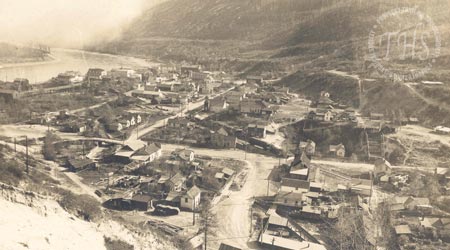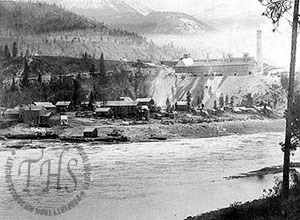 In 1890, the discovery of gold and copper ore on the face of Red Mountain by Joe Moris and Joe Bourgeois was the single most important event in the history of Trail and Rossland area. The five claims then staked led to the rise of Rossland as the premier mining center in North America and the birth of Trail. At the same time, Eugene Sayre Topping and his friend Frank Hanna purchased 343 acres at the mouth of Trail Creek on the Columbia River and surveyed a townsite. The Rossland mines proved to be very rich in gold and copper ore and the lots in the Trail Creek town site sold briskly.
In 1890, the discovery of gold and copper ore on the face of Red Mountain by Joe Moris and Joe Bourgeois was the single most important event in the history of Trail and Rossland area. The five claims then staked led to the rise of Rossland as the premier mining center in North America and the birth of Trail. At the same time, Eugene Sayre Topping and his friend Frank Hanna purchased 343 acres at the mouth of Trail Creek on the Columbia River and surveyed a townsite. The Rossland mines proved to be very rich in gold and copper ore and the lots in the Trail Creek town site sold briskly.
In 1895, a smelter was built on the bench above Trail to process the Rossland ores. The CPR purchased the smelter in 1898. In 1906, the smelter, along with the War Eagle, Centre Star and St. Eugene mines and the Rossland Power Company, were amalgamated to form the Consolidated Mining and Smelting Company of Canada Limited (CM&S, name changed to Cominco in 1966). As the smelter stabilized, the town prospered and the City Council concentrated on providing improved civic services.
In 1912, a new brick school was built and a bridge was constructed across the Columbia River. Trail Creek, running through the town, was culverted and the gully filled with smelter slag, doubling the building area of downtown. A Fall Fair Building/Rink was built on Bay Avenue in 1911. This rink was replaced by the Cominco Arena in 1949. The CM&S purchased the Sullivan Mine in Kimberley in 1910 and the smelter began to rely primarily on lead and zinc ores for its livelihood. In the 1920's, the CM&S expanded its Trail operations. The city grew with the increasing demand for workers at the smelter. Social activities flourished with the production of plays and musicals. Bands, orchestras and choirs were formed, sporting activities increased and CJAT radio was established. The CM&S search for new mines in the Northwest Territories led the company to become a pioneer in aviation exploration. An airport was constructed at Columbia Gardens. A dairy was also established by the CM&S in Warfield.
In the 1920's, the CM&S expanded its Trail operations. The city grew with the increasing demand for workers at the smelter. Social activities flourished with the production of plays and musicals. Bands, orchestras and choirs were formed, sporting activities increased and CJAT radio was established. The CM&S search for new mines in the Northwest Territories led the company to become a pioneer in aviation exploration. An airport was constructed at Columbia Gardens. A dairy was also established by the CM&S in Warfield.
During World War II, production at the smelter was increased. West Kootenay Power Company plants on the Kootenay River were expanded and CM&S participated in the development of the atom bomb. The area entered a period of post-war expansion with the development of residential areas of Sunningdale, Glenmerry, Shavers Bench and the establishment of Warfield, Montrose, Kinnaird and Fruitvale as bedroom communities to Trail.
The Trail smelter had grown to become the largest lead and zinc smelter in the world.





